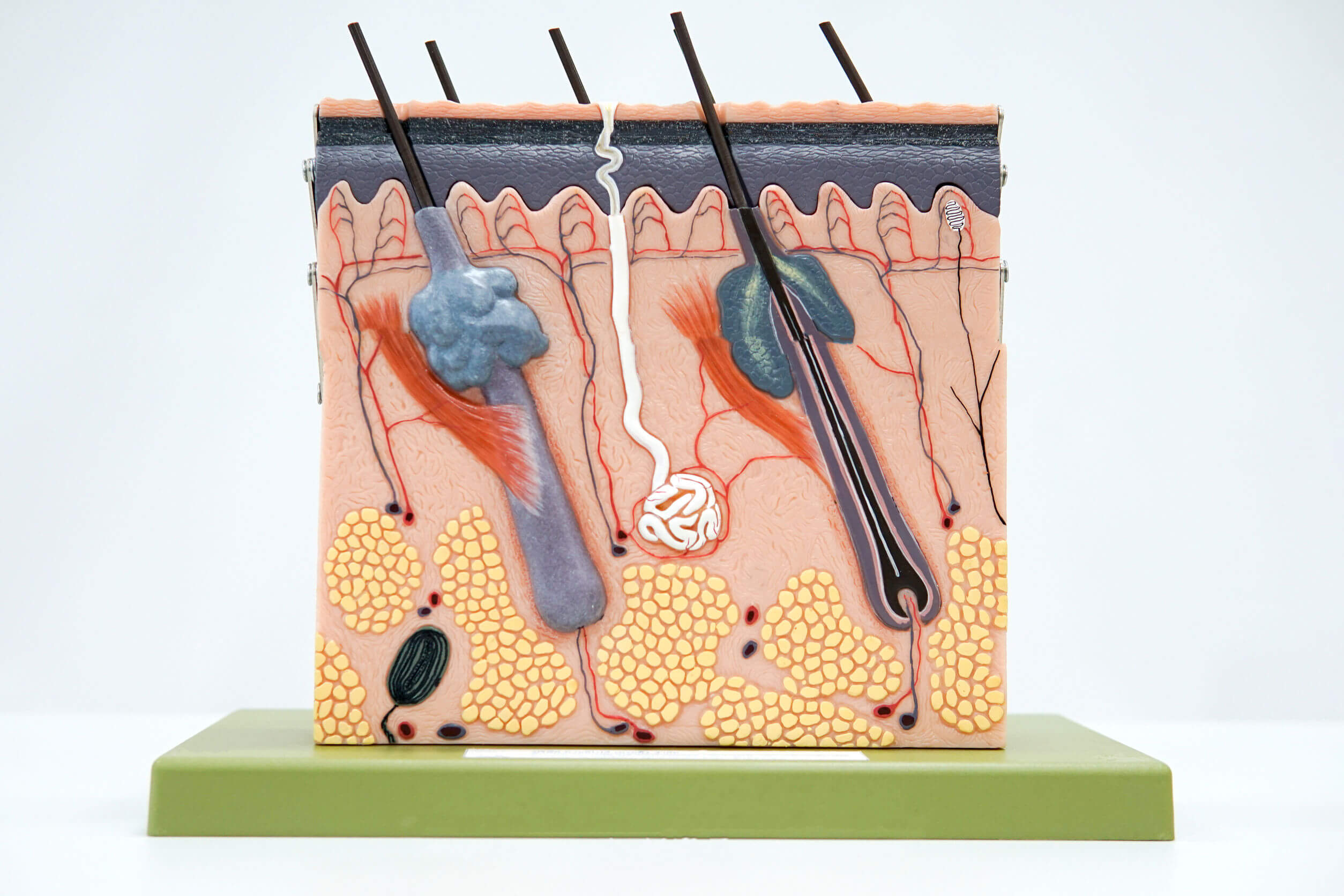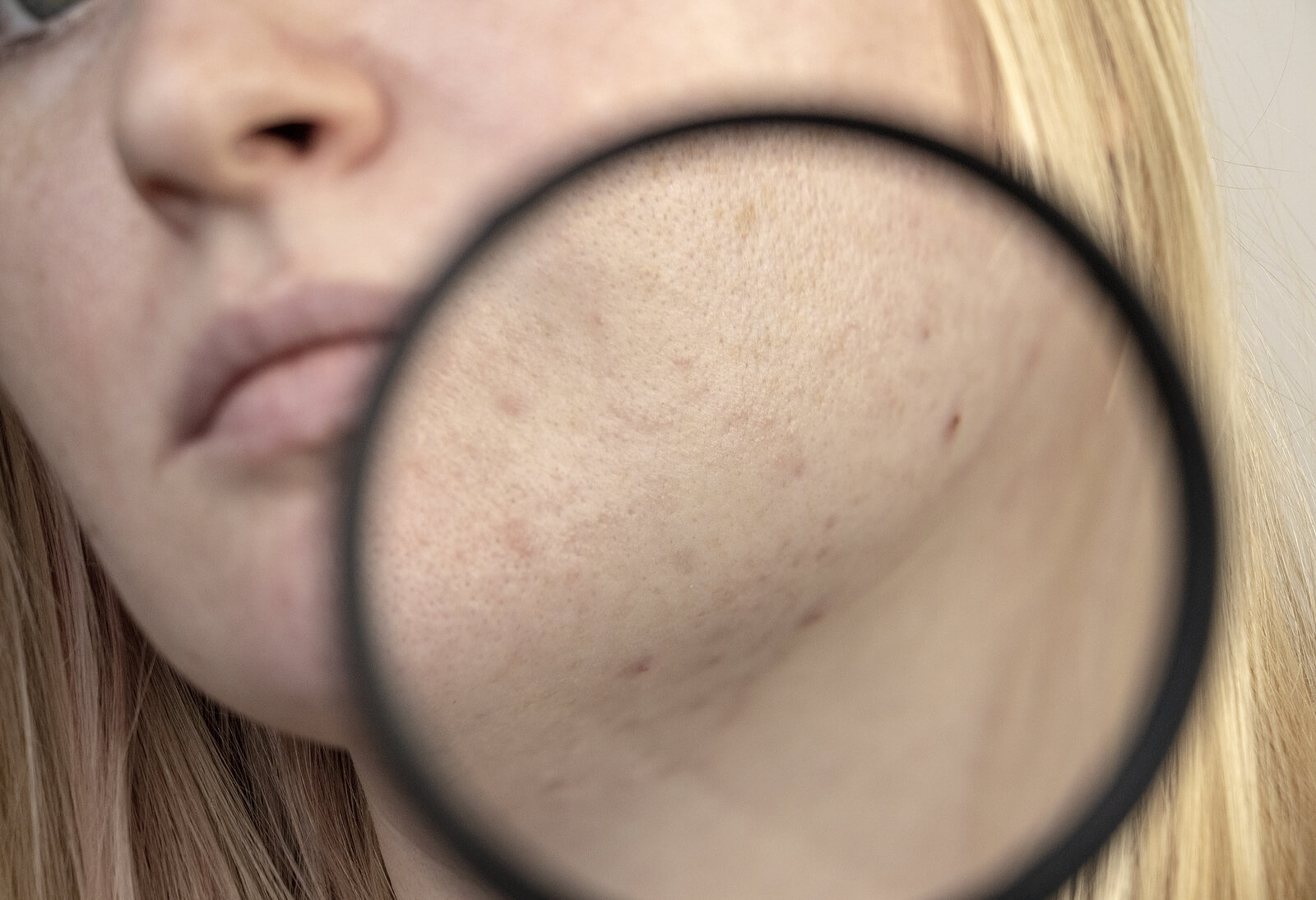Sebaceous Glands: Everything You Need to Know

The sebaceous glands have a bad name. However, contrary to what we tend to believe, they’re not only there to cause discomforts such as acne or shiny skin. Have you ever wondered what else they do for your skin? Find out in this article.
The skin is the largest organ in the body. It’s made up of several layers: epidermis, dermis and hypodermis, and each of these has a series of essential functions that are related to each other.
However, what we usually do is to group them. For this reason, we say that the main function of the skin is to protect the rest of the organs and systems of the body and to contribute to the adaptation to the environment.
What do the sebaceous glands do?

In order to talk about the sebaceous glands in greater detail, we must first brush up on the hypodermis a bit.
According to experts, the hypodermis – also known as the adipose pad or subcutaneous cellular tissue – is the layer of the skin made up of adipocytes (fat cells).
There we can find the pilosebaceous complex, which is made up of hair follicles, hairs, the erector hair muscle, and the sebaceous glands.
Let’s now see a little more about the sebaceous glands, taking into account what is stated in the Dermatology Manual:
- Each hair has between 1 and 4 sebaceous glands associated with it. These are located just above the erector muscle, in the upper portion of the follicle.
- The sebaceous glands develop between the 13th and 16th weeks of fetal development. They’re formed by wide lobes where we find the basement membrane and basophilic cuboid matrix cells that, as they multiply, fill with lipid vacuoles that push and choke the nucleus, becoming clear.
- The secretion of the sebaceous glands is called sebum and is a holocrine substance, since the entire cell body disintegrates to form this secretion. It is composed mainly of triglycerides and phospholipids, although this composition varies with age.
- The sebum contributes to giving sensitivity and permeability (or barrier function) to the skin. It also has emollient, lubricant, fungistatic and bacteriostatic capacity.
- Since the skin isn’t uniform in all parts of the body, the sebaceous glands aren’t uniform either. Their size varies according to the area in which they are. Therefore, in seborrheic areas, they’re larger, and, in less seborrheic areas, they’re smaller.
- We have sebaceous glands on the face and scalp, and also in the so-called periorificial areas (eyes, ears, anus and the junctions with the mucous membranes).
- We rarely have sebaceous glands on the palms of our hands and the soles of our feet.
- As we age, we produce less sebum.
- The sebaceous glands work together with the rest of the skin structures. Specifically, with the eccrine glands, which are responsible for producing sweat to regulate body temperature.
The sebaceous glands are part of the pilosebaceous complex of the skin.
What is its role in the appearance of acne?

Under normal conditions, the sebaceous glands secrete sebum to keep the skin protected and moisturized. However, when there’s some type of disorder that causes an obstruction in them, then comedones, papulopustules, nodules, and even cysts can form.
Several factors are involved in this obstruction, such as follicular keratinization, the activity of sex hormones (such as androgens) and the bacteria Propionibacterium acnes. Also, the application of products on the skin, and the occlusion and pressure of the skin, etc.
So when the sebum outflow to the skin is hampered by dead cells, bacteria grow inside the follicles and then pimples and blackheads appear (which is what we commonly call acne).
What is its role in other skin disorders?
The overgrowth of the sebaceous glands (and other changes in them) can also promote the appearance of other skin problems, such as rosacea, fimatosa rosacea, and seborrheic dermatitis. And, less often, sebaceous nevus or sebaceous carcinoma (a type of skin cancer).
Final recommendations
If you think that your skin is excessively shiny, perhaps you should go through your cosmetics shelf to assess whether you’re really using the right products. And, if after checking them, you’re still not sure, then remember that you can always go to the dermatologist.
Until you have a diagnosis and the specialist’s guidelines to learn how to give your skin the best care and help it maintain a good balance, avoid washing your face too often. You won’t control the amount of sebum just by washing your skin more often.
Nor do you need to exfoliate daily or regularly, or apply alcohol or other products that dry the skin.
Believe it or not, these will sweep away the protective sebum layer that your skin produces, making your skin more vulnerable and exposed to all kinds of discomfort. They’ll also cause the sebaceous glands to produce more sebum, making the problem even more uncomfortable.
On the other hand, remember that, once you start the treatment prescribed by the dermatologist (for acne or any other skin condition), you must be constant, consistent and disciplined in order to see benefits in the following weeks.
The sebaceous glands have a bad name. However, contrary to what we tend to believe, they’re not only there to cause discomforts such as acne or shiny skin. Have you ever wondered what else they do for your skin? Find out in this article.
The skin is the largest organ in the body. It’s made up of several layers: epidermis, dermis and hypodermis, and each of these has a series of essential functions that are related to each other.
However, what we usually do is to group them. For this reason, we say that the main function of the skin is to protect the rest of the organs and systems of the body and to contribute to the adaptation to the environment.
What do the sebaceous glands do?

In order to talk about the sebaceous glands in greater detail, we must first brush up on the hypodermis a bit.
According to experts, the hypodermis – also known as the adipose pad or subcutaneous cellular tissue – is the layer of the skin made up of adipocytes (fat cells).
There we can find the pilosebaceous complex, which is made up of hair follicles, hairs, the erector hair muscle, and the sebaceous glands.
Let’s now see a little more about the sebaceous glands, taking into account what is stated in the Dermatology Manual:
- Each hair has between 1 and 4 sebaceous glands associated with it. These are located just above the erector muscle, in the upper portion of the follicle.
- The sebaceous glands develop between the 13th and 16th weeks of fetal development. They’re formed by wide lobes where we find the basement membrane and basophilic cuboid matrix cells that, as they multiply, fill with lipid vacuoles that push and choke the nucleus, becoming clear.
- The secretion of the sebaceous glands is called sebum and is a holocrine substance, since the entire cell body disintegrates to form this secretion. It is composed mainly of triglycerides and phospholipids, although this composition varies with age.
- The sebum contributes to giving sensitivity and permeability (or barrier function) to the skin. It also has emollient, lubricant, fungistatic and bacteriostatic capacity.
- Since the skin isn’t uniform in all parts of the body, the sebaceous glands aren’t uniform either. Their size varies according to the area in which they are. Therefore, in seborrheic areas, they’re larger, and, in less seborrheic areas, they’re smaller.
- We have sebaceous glands on the face and scalp, and also in the so-called periorificial areas (eyes, ears, anus and the junctions with the mucous membranes).
- We rarely have sebaceous glands on the palms of our hands and the soles of our feet.
- As we age, we produce less sebum.
- The sebaceous glands work together with the rest of the skin structures. Specifically, with the eccrine glands, which are responsible for producing sweat to regulate body temperature.
The sebaceous glands are part of the pilosebaceous complex of the skin.
What is its role in the appearance of acne?

Under normal conditions, the sebaceous glands secrete sebum to keep the skin protected and moisturized. However, when there’s some type of disorder that causes an obstruction in them, then comedones, papulopustules, nodules, and even cysts can form.
Several factors are involved in this obstruction, such as follicular keratinization, the activity of sex hormones (such as androgens) and the bacteria Propionibacterium acnes. Also, the application of products on the skin, and the occlusion and pressure of the skin, etc.
So when the sebum outflow to the skin is hampered by dead cells, bacteria grow inside the follicles and then pimples and blackheads appear (which is what we commonly call acne).
What is its role in other skin disorders?
The overgrowth of the sebaceous glands (and other changes in them) can also promote the appearance of other skin problems, such as rosacea, fimatosa rosacea, and seborrheic dermatitis. And, less often, sebaceous nevus or sebaceous carcinoma (a type of skin cancer).
Final recommendations
If you think that your skin is excessively shiny, perhaps you should go through your cosmetics shelf to assess whether you’re really using the right products. And, if after checking them, you’re still not sure, then remember that you can always go to the dermatologist.
Until you have a diagnosis and the specialist’s guidelines to learn how to give your skin the best care and help it maintain a good balance, avoid washing your face too often. You won’t control the amount of sebum just by washing your skin more often.
Nor do you need to exfoliate daily or regularly, or apply alcohol or other products that dry the skin.
Believe it or not, these will sweep away the protective sebum layer that your skin produces, making your skin more vulnerable and exposed to all kinds of discomfort. They’ll also cause the sebaceous glands to produce more sebum, making the problem even more uncomfortable.
On the other hand, remember that, once you start the treatment prescribed by the dermatologist (for acne or any other skin condition), you must be constant, consistent and disciplined in order to see benefits in the following weeks.
-
“Acne – Health Encyclopedia – University of Rochester Medical Center.” n.d. Accessed June 4, 2021. https://www.urmc.rochester.edu/encyclopedia/content.aspx?contenttypeid=85&contentid=P03373.
-
Bernabéu, Alejandra. 2008. “Acné. Etiología y Tratamiento.” Offarm, 76–80. https://www.elsevier.es/es-revista-offarm-4-articulo-acne-etiologia-tratamiento-13126071.
-
Franco, Gisela Navarrete. 2003. “Histología de La Piel.” MG Rev Fac Med UNAM. Vol. 46. https://www.medigraphic.com/pdfs/facmed/un-2003/un034d.pdf.
- Manual de Dermatología, 2.ª edición. Editores: J. Conejo-Mir, J. C. Moreno, F. M. Camacho, pp. 2-27. ISBN Volumen I: 978-84-7885-628-2. ISBN Obra completa: 978-84-7885-627-5. ISBN Volumen II: 978-84-7885-629-9.
-
Martínez, Carolina, and Joaquín Domínguez. 2018. “Endrocrinología de La Piel.” Revista Venezolana de Endocrinología y Metabolismo 16 (3): 149–66. https://www.redalyc.org/jatsRepo/3755/375557570003/html/index.html.
- Rodríguez Orjales Ileana. Agentes promotores de la permeación percutánea. Rev Cubana Farm [Internet]. 1998 Abr [citado 2021 Jun 04] ; 32( 1 ): 68-75. Disponible en: http://scielo.sld.cu/scielo.php?script=sci_arttext&pid=S0034-75151998000100011&lng=es.
-
“Trastornos de Las Glándulas Sebáceas y de Las Glándulas Apocrinas | Fitzpatrick. Atlas de Dermatología Clínica, 7e | AccessMedicina | McGraw-Hill Medical.” n.d. Accessed June 4, 2021. https://accessmedicina.mhmedical.com/content.aspx?bookid=1512§ionid=98654549.
Este texto se ofrece únicamente con propósitos informativos y no reemplaza la consulta con un profesional. Ante dudas, consulta a tu especialista.







